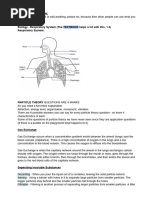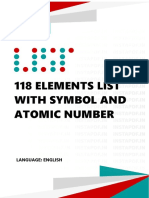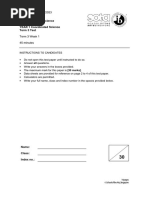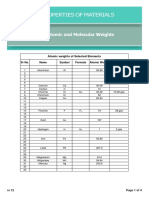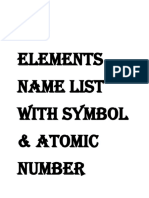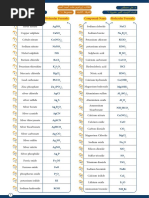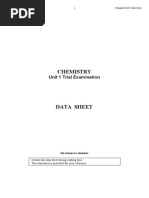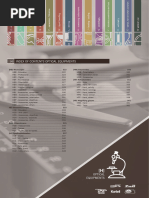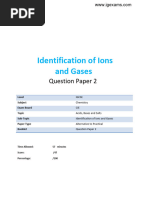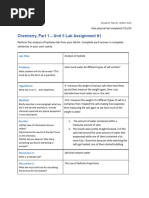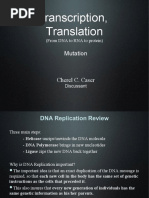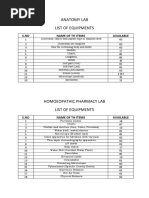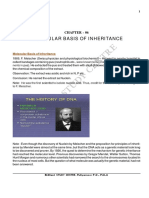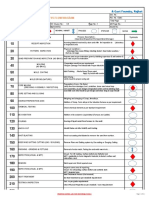Stuvia-370232-Physical-Science-P2-Chemistry-Notes 4
Stuvia-370232-Physical-Science-P2-Chemistry-Notes 4
Uploaded by
drcrafaelCopyright:
Available Formats
Stuvia-370232-Physical-Science-P2-Chemistry-Notes 4
Stuvia-370232-Physical-Science-P2-Chemistry-Notes 4
Uploaded by
drcrafaelOriginal Description:
Original Title
Copyright
Available Formats
Share this document
Did you find this document useful?
Is this content inappropriate?
Copyright:
Available Formats
Stuvia-370232-Physical-Science-P2-Chemistry-Notes 4
Stuvia-370232-Physical-Science-P2-Chemistry-Notes 4
Uploaded by
drcrafaelCopyright:
Available Formats
Physical Science P2 (Chemistry)
Notes
written by
reakeebz
The study-notes marketplace
Buy and sell all your summaries, notes, theses, essays, papers, cases, manuals, researches, and
many more...
www.stuvia.co.za
Downloaded by: drcrafael | drcrafael@icloud.com
Distribution of this document is illegal
Stuvia.com - The study-notes marketplace
Physical Science Paper II
Chemistry Study Notes
Rea’s Notes
Grade 12 Final
2016
3 Hour Exam
200 Marks
Table of Contents
Quantitative Chemistry -------------------------------------------------------------------------------------------------------- 1
Chemical Bonding -------------------------------------------------------------------------------------------------------------- 6
Energy Change & Rates of Reactions -------------------------------------------------------------------------------------- 12
Chemical Equilibrium -------------------------------------------------------------------------------------------------------- 16
Acids & Bases ----------------------------------------------------------------------------------------------------------------- 19
Electrochemistry --------------------------------------------------------------------------------------------------------------- 23
Organic Chemistry ------------------------------------------------------------------------------------------------------------ 31
PREFIXES COMMONLY USED FOR UNITS ------------------------------------------------------------------------- 42
from IEB document
italics = learn by heart
(*) definition formula
not on formula sheet
Downloaded by: drcrafael | drcrafael@icloud.com
Distribution of this document is illegal
Stuvia.com - The study-notes marketplace
Quantitative Chemistry
Balanced Chemical Equations
Polyatomic ions
Negative ions (anions)
-
OH hydroxide SO42- sulphate
NO3- nitrate SO32- sulphite
NO2- nitrite S2O32- thiosulphate
MnO4- permanganate O22- peroxide
CℓO3- chlorate MnO42- manganate
HCO3- hydrogen carbonate (ion) CrO42- chromate
HSO4- hydrogen sulphate Cr2O72- dichromate
HSO3- hydrogen sulphite CO32- carbonate
CH3COO- acetate / ethanoate PO43- phosphate
Positive ions (cations)
+
NH4 ammonium Ag+ silver
H3 O+ hydronium / oxonium Zn2+ zinc (II)
The Periodic Table
meaning:
• element is sodium
• 23 protons & neutrons in nucleus
• nucleons
• 11 protons & 11 electrons
• neutrons: 23 - 11 = 12
• sodium is 11 on the periodic table
• atomic number (23) = number of protons and number of electrons
• atomic mass (11) = number of protons + number of neutrons
• electronegativity is 2,1
No. Name Sym. No. Name Sym.
1 hydrogen H 22 titanium Ti
2 helium He 24 chromium Cr Diatomic elements
3 lithium Li 25 manganese Mn
Magnetic elements
4 beryllium Be 26 iron Fe
5 boron B 27 cobalt Co
6 carbon C 28 nickel Ni
7 nitrogen N 29 copper Cu
8 oxygen O 30 zinc Zn
9 fluorine F 33 arsenic As
10 neon Ne 35 bromine Br
11 sodium Na 47 silver Ag
12 magnesium Mg 50 tin Sn
13 aluminium Al 53 iodine I
14 silicon Si 54 xenon Xe
15 phosphorus P 74 tungsten W
16 sulphur S 78 platinum Pt
17 chlorine Cl 79 gold Au
18 argon Ar 80 mercury Hg
19 potassium K 82 lead Pb
20 calcium Ca 87 francium Fr
92 uranium U
Rea’s Notes | Page 1
Downloaded by: drcrafael | drcrafael@icloud.com
Distribution of this document is illegal
Stuvia.com - The study-notes marketplace
Writing Balanced Chemical Equations
reactants products solid phase
s
crystal lattice
solute
substance which is dissolved
state
precipitate is solid
gaseous phase
↓
g
aqueous
↑
aq
liquid phase
dissolves in solute
ℓ
usually water
solvent
does not partake in reaction
substance in which another
concentrated acid
substance is dissolved
c
Interpret balanced reaction equations in terms of
conservation of atoms
The conservation of atoms in chemical reactions leads to the principle of conservation of matter
and the ability to calculate the mass of products and reactants.
conservation of mass (use relative atomic masses)
during chemical reaction / physical change,
sum of masses of reactants = the sum of masses of products
The Mole Concept
mole SI unit for amount of substance
quantity of matter that has same number of particles (atoms, molecules
mole or ions) as there are atoms in 12 grams of carbon-12
quantity of matter that contains Avogadro’s number of formula units
molar mass (*) mass in grams of one mole of that substance
1 mole contains Avogadro's number of particles ( )
n number of moles mol moles
m mass g grams
-1
M molar mass g.mol grams per mole
Molar Volume of Gases
Avogadro’s Law equal volumes of all gases (@ STP) contain same number of units (atoms/molecules)
n number of moles mol moles
3
V volume of gas dm decimetres cubed
3 -1
Vm molar gas volume @ STP 22,4 dm .mol dm3 per mole
* STP = standard temperature and pressure
get molar mass from periodic table
molar mass of diatomic elements = 2x mass of element
1000cm3 = 1 dm3 = 1ℓ
1 mole of gas occupies 22,4 dm3 at 0°C (273 K) and at 1 atmosphere (101,3 kPa)
Rea’s Notes | Page 2
Downloaded by: drcrafael | drcrafael@icloud.com
Distribution of this document is illegal
Stuvia.com - The study-notes marketplace
Volume relationships in gaseous reactions
Explosions
ammonium nitrate (NH4NO3) used for making explosives
e.g. dynamite Not in IEB doc:
the huge volume of gas suddenly produced causes explosion Volume
all products of reaction are gases, none are dangerous relationships in
2NH4NO3(s) 2N2(g) + 4H2O(g) + O2(g) gaseous reactions
Combustion in car’s engine
spark plug in car’s engine ignites fuel (C8H18) which reacts with oxygen to produce CO2 gas + water vapour
volume of gas produced
large enough to cause pressure build up to push piston down again
provides needed power to move engine + car
2C8H18(l) + 25O2(g) 16CO2(g) + 18H2O(g)
Airbags
inflation of airbag involves chemical reaction that produces large volume of gas which inflates bag
sensors at front of car send electric signal to canister containing sodium azide (NaN 3)
sodium azide then detonated
ignites + starts decomposition reaction producing gas
occurs in 0,03 seconds
2NaN3(s) 2Na(s) + 3N2(g)
Concentration of Solutions
solute substance that is dissolved in solution
solvent substance in which another substance is dissolved, forming solution
number of moles of solute per unit volume of solution
concentration (*)
gives idea of strength of solution
standard solution solution of known concentration
technique where solution of known concentration is used to find info about
titration
solution that it is being reacted with
reaction in which 2 separate solutions are mixed together to form insoluble
precipitation reaction
compound that settles at bottom as solid
precipitate insoluble compound formed during precipitation reaction
chemical that determines how far reaction will go before chemical in question gets
limiting reagent
used up, causing reaction to stop
substance in excess reactant that is left over at end of reaction, once limiting reagent has been used up
c concentration mol.dm-3 moles per dm3
n number of moles mol moles
3
V volume dm decimetres cubed
n number of moles mol moles
N number of particles
NA Avogadro’s number
1 mole contains Avogadro’s number of particles
never changes
weak acid/base
strong acid/base
can change, may add water
dilute acid/base
concentrated acid/base
Rea’s Notes | Page 3
Downloaded by: drcrafael | drcrafael@icloud.com
Distribution of this document is illegal
Stuvia.com - The study-notes marketplace
Standard Solution
From IEB document:
Describe quantitatively and
qualitatively how to make up
a standard solution
Stoichiometric Calculations
Calculations based on chemical equations
1. Make sure equation is balanced Note:
2. Write mole ratio using balanced equation total volume of gaseous
3. Calculate “n” for substance that info was given reactants need not equal total
volume of gaseous products
4. Use mole ratio to calculate “n” for needed substance (multiply)
total number of moles of
5. Use “n” to calculate mass/volume
reactant need not equal total
number of moles of products
Calculations involving limiting reagents
1. Balance equation
2. Determine mole ratio
3. Calculate number of moles for both reactants
4. Compare mole ratio of 2 substances
If n1 = ?? : ?? mol of 2ndsubstance would be required
Rea’s Notes | Page 4
Downloaded by: drcrafael | drcrafael@icloud.com
Distribution of this document is illegal
Stuvia.com - The study-notes marketplace
Percentage yield
measure of extent of reaction, generally measured by comparing amount of product vs amount of
yield
product possible
measures how successful reaction has been
actual and theoretical
yields can be in moles
or mass
1. Balance equation
2. Determine mole ratio
3. Calculate number of moles of reactant
4. Use mole ratio to determine number of moles of product
5. Calculate theoretical mass of product formed
6. Calculate percentage yield
Empirical formula & Molecular formula
empirical formula simplest ratio of substances present in compound
formula based on its molecular weight / relative atomic mass
molecular formula
shows actual number of atoms of each constituent element
Determining empirical formula
1. Convert % into mass (g)
assume total mass = 100g
2. Obtain molar mass (from periodic table) Not in IEB doc:
Calculate number of moles Empirical formula
3. Divide each mole value by smallest n calculated & Molecular
4. Round values to nearest whole number formula
if at .5, multiply by 2
if between .4 – .6, find LCD
5. Use these numbers as empirical formula
Determining molecular formula
first determine empirical formula
compare relative molecular mass of empirical formula compound to relative molecular mass given
to determine molecular formula:
multiply compound through by number from molecular formula formula
Percentage purity
not all samples of chemical are 100% pure
Rea’s Notes | Page 5
Downloaded by: drcrafael | drcrafael@icloud.com
Distribution of this document is illegal
Stuvia.com - The study-notes marketplace
Chemical Bonding
Intramolecular Bonds
Chemical bond
intramolecular bond bond occurring between atoms within molecules
pair of electrons shared between 2 atoms
bonding pair
each atom contributes one electron towards bonding pair
chemical bond net electrostatic force 2 atoms which share electrons exert on each other
electrostatic force force of attraction/repulsion between charged particles
lone pair pair of valence electrons belonging to atom not involved in bonding
electrons in outer energy level of atom that can form chemical bonds with other
valence electrons
atoms
Aufbau Diagram & Lewis Structure
e.g. phosphorus
Aufbau diagram Lewis structure Details
atomic no. / electrons: 15
group no. / valence electrons: 5
valency: -3
Bonding
atoms always want to be in stable state
ensure have no unpaired electrons
electrostatic forces
attraction: moves closer together
repulsion: moves further apart
molecule most stable when potential energy is at lowest
Couper notation
Formula Lewis diagram Couper structure
H2 O
Molecules with multiple bonds between atoms
F2 O2 N2
Rea’s Notes | Page 6
Downloaded by: drcrafael | drcrafael@icloud.com
Distribution of this document is illegal
Stuvia.com - The study-notes marketplace
Molecules with dative covalent or co-ordinate covalent bonds
atom with incomplete no. of electrons shares lone pair of electrons belonging to another atom
e.g. formation of ammonium & hydronium ions
Electronegativity of atoms to explain polarity of bonds
a measure of the tendency of atom to attract bonding pair of electrons
electronegativity
ability of atom in molecule to attract shared pair of electrons toward itself
covalent bond sharing of at least one pair of electrons by 2 atoms
covalent bond in which shared electrons are found an equal distance between the 2
non-polar covalent
atoms as atoms have same electronegativity
bond
(pure covalent) equal sharing of electrons
covalent bond in which shared electrons are positioned closer to 1 atom as atoms
have different electronegativities
polar covalent bond
unequal sharing of electrons leading to dipole forming (as result of
electronegativity difference)
ionic bond transfer of electrons and subsequent electrostatic attraction
metallic bonding bonding between a positive kernel and a sea of delocalised electrons
polar bond electron pairs are shared unequally, i.e. partially +’ve side & partially –’ve side
dative covalent bond occurs when shared electron pair between 2 atoms is provided by one of atoms
molecule in which there is unequal distribution of charge
polar molecule resulting in overall +’ve & –’ve side of molecule
has asymmetrical distribution of charge
molecule in which there is equal distribution of charge
non-polar molecule opposite ends of molecule have same charge
has symmetrical distribution of charge
polarity difference in electronegativity
Non-polar covalent bonds
atoms of bond are identical
e.g. H2 & Cℓ2
same attraction
Polar covalent bonds
atoms not identical
e.g. HCℓ (H+) (Cℓ-)
electron pair not halfway
Determining polarity
Difference of Type of bond Explanation
> 2,1 ionic complete electron transfer would take place
1 – 2,1 covalent, polar
<1 covalent, very weakly polar
=0 covalent, non-polar
Rea’s Notes | Page 7
Downloaded by: drcrafael | drcrafael@icloud.com
Distribution of this document is illegal
Stuvia.com - The study-notes marketplace
Bond energy and bond length
bond energy amount of energy absorbed to break chemical bond / released when new bond is formed
bond length average distance between nuclei of 2 bonded atoms in molecule
bond order refers to no. of bonds that occur between 2 atoms
Determining strength of chemical bond
bond length
closer greater attraction stronger bond
size of atoms
smaller molecules greater bond energy stronger bond
no. of bonds between 2 atoms (bond order)
double bond stronger than single bond
i.e. greater bond order stronger bond
Other factors which affect intramolecular bonds
in giant structures
e.g. diamond, graphite and silicon dioxide
melting & boiling points are high
due to strong covalent bonds being broken
in giant ionic solids
e.g. sodium chloride
melting points & boiling points determined by electrostatic forces of attraction (ionic bonds) between
cations and anions in lattice structure
Rea’s Notes | Page 8
Downloaded by: drcrafael | drcrafael@icloud.com
Distribution of this document is illegal
Stuvia.com - The study-notes marketplace
Intermolecular Forces
Intermolecular and interatomic forces
In a liquid or a solid there must be forces between the molecules causing them to be attracted to one
another, otherwise the molecules would move apart and become a gas.
IMF (intermolecular force) – weak force of attraction between molecules/atoms of noble gases
dissociation process whereby ionic compounds break up into ions in presence of water
intermolecular forces are between molecules, intramolecular bonds are between atoms of molecules
Types of intermolecular forces between molecules and in mixtures of covalent
compounds
dipole pair of equal & oppositely charged / magnetised poles separated by distance
temporary dipole that is only polar for as long as electrons in naturally non-polar
induced dipole atom/molecule are positioned in way to form dipole
i.e. non-polar atom/molecule has electrons positioned more to one side
Type of force Strength Between which molecules
London / induced dipole- weakest induced dipoles
induced dipole forces (van der Waals) can exist between mixture of non-polar substances
weak, short- uncharged molecules
van der Waals forces
range arising from interaction of permanent/induced dipoles
weak polar covalent molecules, there is an electronegativity
dipole-dipole
(van der Waals) difference
weak polar molecule induces dipole in atom/non-polar molecule by
dipole-induced dipole
(van der Waals) disturbing arrangement of electrons in non-polar molecule
special dipole-dipole forces
hydrogen bonds with small highly electronegative atom
hydrogen bonds strongest H with N/O/F
higher boiling points than with other hydride molecules in
same group
Solubility of substances
solubility ability of 1 substance to dissolve in another
solute substance that is dissolves in solution
solvent substance in which another substance is dissolved, forming solution
like dissolves like
if both solute & solvent polar or both non-polar
solute will likely dissolve
if one is polar other non-polar
solute will likely not dissolve
Types of intermolecular forces in mixtures containing ionic compounds
Type of force Between molecules Info
when ionic substance dissolves in water, it dissociates into its ions
water molecules are unable to remove ions from crystal lattice
because individual ion-dipole forces are weak & can’t
overcome ionic forces of crystal lattice
ion-dipole ionic compound & polar
however combined forces of many water molecules will
(van der Waals) covalent compound overcome ionic forces
pulls ions out of crystal lattice
ions classified as ‘polar’
ionic substances dissolve well in polar solvents
Rea’s Notes | Page 9
Downloaded by: drcrafael | drcrafael@icloud.com
Distribution of this document is illegal
Stuvia.com - The study-notes marketplace
dissociated ions from ionic substance induces non-polar
ion-induced atom/molecule
polar substances &
dipole there is attractive force
induced dipoles ions classified as ‘polar’
(van der Waals)
ionic substances do not dissolve well in non-polar solvents
Physical state and density in terms of intermolecular forces
measure of number of molecules in material per unit of volume
density
/how closely packed molecules are in object
heat conduction transfer of heat energy from one vibrating particle to next in material
Strength of IMFs vs melting/boiling points
stronger IMFs greater energy needed to break forces between molecules higher melting + boiling
points
solid stronger IMFs harder to break has higher melting + boiling points
Strength of van der Waals forces VS molecular size
the bigger the molecule, the stronger the IMF
bigger electron cloud longer molecule more points for force contact stronger IMF
Strength of IMFs vs density
solids have highest density, gas has lowest density
solid: molecules held closer together stronger IMFs
gas: molecules too far apart virtually non-existent IMFs
Strength of IMFs vs thermal expansion
weaker IMFs less energy required to break apart to undergo phase change
same within same phase of substance
in an alcohol thermometer
heated
IMFs between alcohol molecules weaken
moving them further apart
alcohol expands
causing movement up tube
indicate rise in temp
cooled
molecules move closer together
alcohol begins to contract
IMFs strengthen
Strength of IMFs vs thermal conductivity in metals & non-metals
metals better conductors of heat than non-metals
to be able to conduct heat
must be able to undergo heat conduction
particles of substance must be able to vibrate as receive energy
then transfer to neighbouring particles
seen from metallic lattice
electrons are free to move within lattice, therefore collide with one another to transfer heat
metals have stronger IMFs
metal particle held closely together
better thermal conductors than non-metals
Rea’s Notes | Page 10
Downloaded by: drcrafael | drcrafael@icloud.com
Distribution of this document is illegal
Stuvia.com - The study-notes marketplace
Chemistry of water
amount of heat energy that must be supplied to 1kg of substance for it to overcome
heat of vaporisation
its IMFs and change from liquid to gas/vapour
water contains hydrogen bonds
very strong
boiling point of water is higher than expected
Not in IEB doc:
without H-bonds, all water on earth would be in gaseous phase Chemistry of
causes solid water to have more open crystalline structure water
ice is less dense than water
angular shape of water molecules + hydrogen bonds between them
causes molecules to arrange selves into 3D hexagonal lattice, large spaces in centre
presence of H-bonds & shape of lattice is reason ice floats in water
water has high heat of vaporisation
Rea’s Notes | Page 11
Downloaded by: drcrafael | drcrafael@icloud.com
Distribution of this document is illegal
Stuvia.com - The study-notes marketplace
Energy Change & Rates of Reactions
Energy Changes in Reactions
enthalpy heat content / amount of energy within substance
net change of chemical potential energy of system
heat of reaction (ΔH)
change in enthalpy or amount of heat absorbed/released during a chemical reaction
reaction in which energy is absorbed ( )
endothermic reaction
reaction which transfers thermal energy into potential energy
reaction in which energy is released {heat given out as product} ( )
exothermic reaction
reaction which transfers potential energy into thermal energy
thermodynamics science of heat / energy flow in chemical reactions
compound which speeds up reaction without taking part in reaction
catalyst lowers activation energy in reaction
substance that increases rate of reaction but remains unchanged at end of reaction
H enthalpy / heat of reaction kJ kilojoules
H = Hproducts Hreactants Hproducts energy of products kJ kilojoules
Hreactants energy of reactants kJ kilojoules
OR
H enthalpy / heat of reaction kJ kilojoules
activation energy / energy
H= activation given out activation kJ kilojoules
taken in
given out energy given out kJ kilojoules
in chemical reactions
existing bonds are broken requiring energy
new bonds are formed releasing energy
stronger bond requires more energy to break and releases more energy when formed
if energy absorbed = energy released; reaction is reversible
Endothermic and exothermic reactions
Endothermic
net energy absorbed (as reactant)
energy of products is higher than energy of reactants
Hproducts > Hreactants
ΔH is +’ve
existing bonds are broken
Exothermic
net energy released (as product)
energy of products is lower than energy of reactants
Hproducts < Hreactants
ΔH is –’ve
new bonds are formed
e.g. of exothermic reactions
combustion of fuel: fuel + O2 CO2 + H2O + energy
respiration: C6H12O6 6CO2 + 6H2O + energy
e.g. of endothermic reaction
sunlight energy
photosynthesis: 6CO2 + 12H2O C6H12O6 + 6O2 + 6H2O
Rea’s Notes | Page 12
Downloaded by: drcrafael | drcrafael@icloud.com
Distribution of this document is illegal
Stuvia.com - The study-notes marketplace
Activation energy
activation energy ( ) minimum energy required to start chemical reaction
temporary transition state between reactants & products
activated complex transition state for molecules in reaction which have already broken apart & are no
longer reactant molecules, nor are they yet product molecules
for substances to react molecules must
collide with one another
have correct orientation
have kinetic energy activation energy
if not enough energy to collide successfully, must absorb some energy
activation energy is required for exo- & endothermic reactions
Endothermic
reactants not have enough energy to break bonds
between them
so need to absorb energy before able to react
absorb activation energy
increase their potential energy
when molecules reach activated complex
able to collide
reactant molecules broken apart
particles @ activated complex bond to form products
release energy
energy absorbed in reaching activated complex >
amount of energy released
Exothermic
energy needs to be absorbed before reaction can occur
energy absorbed in reaching activated complex <
amount of energy released
Rea’s Notes | Page 13
Downloaded by: drcrafael | drcrafael@icloud.com
Distribution of this document is illegal
Stuvia.com - The study-notes marketplace
Rates of Reaction
reaction rate (*) change in concentration per unit time of either reactant or product
the speed at which a reaction occurs is directly proportional to:
collision theory number of collisions per unit time between reacting particles
fraction of these collisions that are effective
Factors Affecting Rate
nature of reacting substances
factors which determine speed that particles have to collide with for reaction to be effective
type, strength, number of chemical bonds between atoms
e.g. simple ions’ reactions are usually instantaneous
+’ve & –’ve charges attract each other & no bonds have to be broken to create new substances
e.g. NaCl(aq) becomes Na+ and Cl– ions
but reaction between molecules are slower
bonds must be broken & new bonds must form
by affecting frequency of collisions
concentration
if conc. is increased, particles are closer together
more effective collisions per unit time reaction rate increases
only for solutions
because
conc. of solids cannot be changed
conc. of gas only changed by changing pressure
pressure
if pressure is increased, particles are closer together
more effective collisions per unit time reaction rate increases
only for gases
surface area
solid broken up into little pieces increase total surface area of reactants
total number of particles available for reacting increases
more effective collisions per unit time reaction rate increases
only for solids
+ temperature (below)
by affecting energy of collisions
temperature
as temp increases, kinetic energy increases, speed of molecules increases
therefore molecules collide more frequently
more effective collisions
reaction rate increases
temperature increase of 10°C usually doubles rate of reaction
catalysts
Maxwell Boltzmann distribution curve
Rea’s Notes | Page 14
Downloaded by: drcrafael | drcrafael@icloud.com
Distribution of this document is illegal
Stuvia.com - The study-notes marketplace
Measuring Rates of Reaction
or
experimental techniques for measuring the rate of a given reaction
volume of gas liberated over time
colour change seen over time
volume of precipitate formed over time (turbidity)
loss in mass of reactant over time (if product released as gas)
gain in product mass over time
rate at which product is formed = rate at which reactant is used up
Effect of a Catalyst
catalyst substance that increases rate of reaction but remains unchanged at end of reaction
catalysts
takes part in reaction but remains unchanged at end
do not cause reaction to take place that wouldn’t have taken place already
function by interacting with reactants so reaction follows alternative path of lower activation energy
i.e. lowers activation energy needed for reaction
do not change enthalpy ( ) of reaction
do not affect volume of product formed, only speed at which products form
graphs show how adding a catalyst affects the rate of reaction
energy profile graph
Maxwell Boltzmann distribution curve
rate vs time
quantity vs time
mass of catalyst before = mass of catalyst after
Rea’s Notes | Page 15
Downloaded by: drcrafael | drcrafael@icloud.com
Distribution of this document is illegal
Stuvia.com - The study-notes marketplace
Chemical Equilibrium
Chemical Equilibrium and Factors Affecting Equilibrium
one in which system is isolated from its surrounding environment in such a way
closed system
that there is no mass transferred into or out of system
one in which mass or energy can be transferred into or out of system during
open system
reaction
reaction that does not go to completion and occurs in both forward and reverse
reversible reaction
direction
reaction in which the forward and reverse reaction continue to take place
dynamic equilibrium
simultaneously, at the same rate
reaction can only reach equilibrium if
reaction is reversible
system is closed
reaction has reached equilibrium if
rate of forward reaction = rate of backward reaction
or volume/concentration of reactants & of products are constant (not necessarily equal)
Application of Equilibrium Principles
Le Chatelier's when external stress (change in pressure / temperature / concentration) is applied to
principle system in chemical equilibrium, equilibrium point will change so as to counteract the stress
use Le Chatelier's principle to predict the effects of changes of ___ on the concentrations and amounts of
each substance in an equilibrium mixture
pressure
increase in pressure: reaction that proceeds towards least number of moles of gas is favoured
decrease in pressure: reaction that proceeds towards most number of moles of gas is favoured
if number of moles of reactants = products, equilibrium is maintained despite pressure
increasing pressure increases both forward & backward reaction rates, but one is favoured (moles)
when comparing moles of products/reactants, ignore (s) & (l) as not affected by pressure
temperature
a value means that forward reaction is endothermic
a value means that forward reaction is exothermic
increase in temp favours endothermic reaction
decrease in temp favours exothermic reaction
exothermic reaction produces heat which relieves stress of low temperature
increasing temp increases rates of both forward & backward reactions, but one will increase more
concentration (common ion effect)
reaction that favours counteracting the change will be favoured
e.g. add more reactant, forward reaction favoured
adding (s) or (l) has no effect on equilibrium position
NB: [molecule] = concentration of molecule
common ion effect
if compound added to equilibrium system contains ion already present in system
reaction which uses up that ion will be favoured (NB dissociation)
CATALYSTS DO NOT AFFECT EQUILIBRIUM POSITION
speeds up both forward and reverse reactions equally
so have no effect on equilibrium
cause equilibrium to be reached sooner
graphs
rate graphs
rates of both forward and backward will become equal when equilibrium occurs
amount vs time graphs
in closed system
amounts become constant when equilibrium occurs (not necessarily equal)
Rea’s Notes | Page 16
Downloaded by: drcrafael | drcrafael@icloud.com
Distribution of this document is illegal
Stuvia.com - The study-notes marketplace
use collision theory to explain changes predicted by Le Chatelier's principle
measure of extent of reaction, generally measured by comparing amount of product vs amount of
yield
product possible
Industrial Processes
used in preparation of fertilisers
Haber process
formation of ammonia (NH3)
conditions that will bring about high product yield:
high pressure
compressors that can withstand very high pressures are expensive so not economical to
increase pressure higher than 200 times atmospheric pressure
low temperature
too low temperature lowers reaction rate too much
Ek of molecules too low, not enough activation energy to form activated complex
takes too long to reach equilibrium & uneconomical
moderate temperature of 500°C is chosen for this reaction
removal of NH3
addition of N2 or H2
addition of catalyst (iron (Fe) or iron oxide (FeO))
enlarge surface area of catalyst (more finely subdivided)
Contact process
formation of sulphuric acid (H2SO4)
only part of process which is reversible:
conditions that will bring about high product yield (sulphur trioxide): (same as with Haber)
high pressure
ideal: 1 times atmospheric pressure
low temperature
ideal: 450°C
removal of SO3
addition of O2 or SO2 (sulphur dioxide)
addition of catalyst (vanadium pentoxide, V2O5)
enlarge surface area of catalyst (more finely subdivided)
Ostwald process
formation of nitric acid (HNO3) in 3 steps:
Rea’s Notes | Page 17
Downloaded by: drcrafael | drcrafael@icloud.com
Distribution of this document is illegal
Stuvia.com - The study-notes marketplace
Equilibrium Constant
expression of concentration of products over concentration
equilibrium constant of reactants for reaction that is in equilibrium
tells us equilibrium ratio of products to reactants
: at equilibrium, more products than reactants
: at equilibrium, more reactants than products
when calculating equilibrium constant
equation must be balanced
only gases and aqueous solutions are included in the KC equation
KC changes as temp changes
temperature is the only factor which influences the value of equilibrium constant
if change in temp causes KC to increase
forward reaction was favoured
caused conc. of products to increase & conc. of reactants to decrease
KC increased
(endothermic forward reaction)
is written as
calculate KC given
equilibrium concentrations or moles and volumes of all relevant species
calculate concentrations stoichiometrically
or use below steps
initial concentrations (or moles) of all species and the equilibrium concentration (or moles) of one
species
set up table as shown
use balanced equation to determine mole ratio
put given info into table
calculate what is possible to calculate
mole ratio only applies to used / formed row
once number of moles (n) @ equilibrium known, use to calculate conc. @ equilibrium
then use conc. of each substance @ equilibrium to calc. KC
Rea’s Notes | Page 18
Downloaded by: drcrafael | drcrafael@icloud.com
Distribution of this document is illegal
Stuvia.com - The study-notes marketplace
Acids & Bases
Grade 10-11 Revision
ampholyte substance that may act as acid or base
conjugate acid-base pairs compounds that differ by presence of 1 proton / H + ion
salt ionic compound produced by reacting acid with base
Acids Bases
sour taste slippery feel
corrosive to metals
Ampholytes
some substances can act as acid or base
e.g. water
able to donate/accept protons
depends on what substance reacting with
said to be “amphoteric”
e.g. with H2O
acid:
base:
Conjugate acid-base pairs
all acids have conjugate base which is formed when proton has been donated
all bases have conjugate acid, formed after have accepted proton
e.g.
pair 1:
acid = HCℓ
conjugate base = Cℓ-
pair 2:
base = NH3
conjugate acid = NH4+
to find conjugate base
take away H+
to find conjugate acid
add H+
Rea’s Notes | Page 19
Downloaded by: drcrafael | drcrafael@icloud.com
Distribution of this document is illegal
Stuvia.com - The study-notes marketplace
Grade 12 Work
Lowry-Brønsted theory
acid is defined as a proton donor
Lowry-Brønsted theory of acids and bases
base is defined as a proton acceptor
acid: any substance that can donate hydrogen ion
base: substance that accepts hydrogen ions
Common Names
Common Strong Acids Common Strong Bases
hydrochloric acid HCℓ sodium hydroxide (caustic soda) NaOH
nitric acid HNO3 potassium hydroxide KOH
sulphuric acid H2SO4 magnesium hydroxide Mg(OH)2
calcium hydroxide Ca(OH)2
group 1 hydroxides
Common Weak Acids Common Weak Bases
ethanoic acid / acetic acid / vinegar CH3COOH ammonia NH3
hydrofluoric acid HF sodium carbonate Na2CO3
phosphoric acid H3PO4 sodium bicarbonate NaHCO3
sulphurous acid H2SO3 carbonates
Ionisation and Dissociation (Arrhenius’ theory)
acids ionise in solution to produce H+ ions
& ultimately H3O+ ions
hydrogen ion
bases dissociate in solution to produce OH- ions
hydroxide ion
e.g.
acid (ionise)
HCℓ(aq) H+(aq) + Cℓ-(aq)
H+ cannot exist on own in solution, so combine with water molecule:
H+(aq) + H2O(l) H3O+(aq)
hydronium ions give acids their properties
base (dissociate)
NaOH(aq) Na+(aq) + OH-(aq)
Acidity
strong acid acid that ionises almost completely in aqueous solution
strong base base that dissociates almost completely in aqueous solution
weak acid acid that only ionises partially in aqueous solution
weak base base that only dissociates partially in aqueous solution
Rea’s Notes | Page 20
Downloaded by: drcrafael | drcrafael@icloud.com
Distribution of this document is illegal
Stuvia.com - The study-notes marketplace
never changes
strong acid/base
have high Kc values
weak acid/base
have low Kc values
can change, may add water
concentrated acid/base
indicates how many acid/base molecules there are per unit volume in the liquid
ratio of amount of solute to volume of solvent in solution
concentrations usually >4-5mol.dm-3
dilute acid/base
when acid/base is in small proportion to water
concentrations usually <2mol.dm-3
using equilibrium constant to determine strength
of pure acid: Ka = ionisation constant of acid = Kc
of pure base: Kb = dissociation constant of base = Kc
K > 1: strong acid/base
K < 1: weak acid/base
NB H2O is a pure liquid so [H2O] = 1
conductivity and acid strength
acid which strongly conducts electricity
contains a greater number { higher concentration} of ions in solution (high degree of ionisation
{dissociation for bases})
strong acid
polyprotic acids acids that are able to donate 2+ protons e.g. H2SO4 can donate 2 protons in 2 separate steps
Auto-ionisation of water
auto-ionisation
when substance transfers 1 proton from 1 molecule of its own to another of its own
(autoprotolysis)
H2O(ℓ) + H2O(ℓ) H3O+(aq) + OH– (aq) (water must be at 25°C)
dissociation constant for water = KW = [H3O+][OH–] (because H2O is pure liquid)
KW = [H3O+][OH–] = at 298 K (25°C)
pH
pH scale runs from 0 to 14
acidic solutions: because
neutral solutions: because
basic solutions: because
Explain pH scale as measure of hydronium ion (H3O+) concentration in water @ 25°C
Explain qualitatively pH range of 0-14
salt substance in which hydrogen of acid has been replaced by cation
point where acid & base have reacted so neither is in excess
neutralisation
equivalence point
hydrolysis of salt reaction with water where water itself is decomposed
Rea’s Notes | Page 21
Downloaded by: drcrafael | drcrafael@icloud.com
Distribution of this document is illegal
Stuvia.com - The study-notes marketplace
Reactions to remember
acid + metal hydroxide salt + water HCℓ + NaOH NaCℓ + H2O
acid + metal oxide salt + water 2HCℓ + CaO CaCℓ2 + H2O
acid + metal carbonate salt + water + carbon dioxide HNO3 + Na2CO3 2NaNO3 + H2O + CO2
acid + active metal salt + hydrogen NB: A redox reaction
Indicators
chemical pigment which is a weak acid with differently coloured acid and conjugate base forms
Colour in pH range where colour
Indicator Colour in acid Colour in alkali
neutral solution change occurs
litmus red purple blue 7,0
bromothyl blue yellow green blue 6,0 – 7,6
methyl orange orange yellow yellow 3,1 – 4,4
phenolphthalein colourless colourless pink 8,3 – 10,00
methyl red red yellow yellow 4,4 – 6,2
Use Le Chatelier's principle to predict the colour of the indicator in different acidic and basic media
Acid-base titrations
titration determines concentration of acid/base by exactly neutralising the acid/base with a base / acid of
known concentration
equivalence point: where equal molar amounts of the acid and base have reacted according to the molar
ratio
end point: point where indicator changes colour
ideally end point must also be equivalence point
pH of equivalence point can be estimated using:
indicator to use
strong acid + strong base neutral solution bromothyl blue
strong acid + weak base acidic solution methyl orange
weak acid + strong base basic solution phenolphthalein
Titration reactions
at equivalence point:
number of moles of H+ = number of moles of OH-
Step 1. write balanced equation for reaction
Step 2. determine mole ratio
a acid + b base products
Step 3. substitute into:
Step 4. calculate unknown quantity
Rea’s Notes | Page 22
Downloaded by: drcrafael | drcrafael@icloud.com
Distribution of this document is illegal
Stuvia.com - The study-notes marketplace
Electrochemistry
Redox Reactions
oxidation loss of electrons
reduction gain of electrons
substance that accepts electrons
oxidising agent
substance that will assist oxidising process by itself undergoing reduction
substance that donates electrons
reducing agent
substance that will assist reduction process by itself undergoing oxidation
oxidation number charge that atom would have if compound was composed of ions
only used as a tool, not scientific
ion that remains unchanged on both sides of equation & does not participate in
spectator ion
redox reaction
electrode half-cell
anode electrode where oxidation takes place
cathode electrode where reduction takes place
electroplating process of coating substance with thin layer of metal
decomposition reaction compound divides into elements
displacement reaction 1 substance displaces an element from another compound
synthesis reaction 2 / more substances combine to form compound
OIL RIG
Oxidation Is Loss Reduction Is Gain
Oxidation numbers
= measure of electron richness
= oxidation state of atom
= number of charges atom would have in molecule if bonding electrons were transferred completely
Rule / State Oxidation Number Example(s)
single unbonded atoms / unreacted element 0 Na, Fe, S
diatomic molecules 0 Cℓ2, H2
oxygen in compound 2-
hydrogen in compound 1+
elements in group 1 1+
elements in group 2 2+
elements in group 7 1-
sum of ONs in neutral compound 0
sum of ONs in polyatomic ion charge of ion
Redox reactions
involve transfer of electrons
oxidation reduction
loss of electrons gain of electrons
increase of ON decrease of ON
substance that loses electrons is said to be substance that gains electrons is said to be
oxidised reduced
takes place at anode takes place at cathode
ANOX REDCAT
Rea’s Notes | Page 23
Downloaded by: drcrafael | drcrafael@icloud.com
Distribution of this document is illegal
Stuvia.com - The study-notes marketplace
e.g.
Mg loses 2e- Ni2+ gains 2e-
oxidised reduced
ON increases ON decreases
reducing agent oxidising agent
Synthesis reaction
Na = oxidised, reducing agent
Cℓ2 = reduced, oxidising agent
Decomposition reaction
H2O = oxidised; O2- loses 2e- O2
H2O = reduced; each H+ ion gains 1e- H2
H2O = both oxidising & reducing agent
Displacement reaction
Fe = oxidised, Fe loses 2e- Fe2+
Cu2+ = reduced, Cu2+ gains 2e- Cu OHR: Fe0 Fe2+ + 2e-
SO4 = spectator ion RHR: Cu2+ + 2e- Cu0
electroplating would occur
Balancing redox reactions
assign ON to reactant & products
separate equation into half equations
oxidation half reaction (OHR)
reduction half reaction (RHR)
balance each separately
add 2 half reactions together to give balanced overall reaction
Galvanic Cells
consists of 2 half-cells connected by salt-bridge & external conductor
salt-bridge filled with inert solution
does not react with anything in half-cells
separates electrolytes so don’t mix
completes electric circuit
supplies path through which ions move
ensures electrolytes remain neutral
anions move towards anode
cations move towards cathode
e.g. NaNO3, KNO3, NH4NO3, Na2SO4
each half-cell contains solution with respective metal
spontaneous reactions occur in half-cells
chemical energy is transformed to electrical energy
+’ve ions (cations) flow through salt bridge to cathode
–’ve ions (anions) flow through salt bridge to anode
Rea’s Notes | Page 24
Downloaded by: drcrafael | drcrafael@icloud.com
Distribution of this document is illegal
Stuvia.com - The study-notes marketplace
Cell notation
in active electrodes:
e.g. Zn(s) | Zn2+(aq) || Cu2+(aq) | Cu(s)
+ -
in inactive electrodes (usually Pt or C)
Relation of Current and Potential to Rate and Equilibrium
galvanic cell
has capacity to deliver current until reaction reaches chemical equilibrium or has run to completion
after this, voltage is 0
explain using Le Chatelier's principle:
factors that favour the forward reaction increase voltage of galvanic cell
factors that favour the reverse reaction decrease voltage
e.g. concentration
increasing surface area of terminals increases rate of reaction
which increases cell’s capacity to deliver current
but does not affect emf of cell
wider, shorter and more conductive salt bridge lowers internal resistance
which increases cell’s capacity to deliver current
but does not affect emf of cell
Example of Galvanic Cell (Zn/Cu)
net reaction:
Zn(s) + Cu2+(aq) Zn2+(aq) + Cu(s)
sulphite ion (SO42-) is spectator ion so can be omitted
Rea’s Notes | Page 25
Downloaded by: drcrafael | drcrafael@icloud.com
Distribution of this document is illegal
Stuvia.com - The study-notes marketplace
Standard Electrode Potentials (SEP)
when 2 half-cells are set up and each of the metal electrodes are placed in an electrolyte the
electrode can either donate ions (is oxidised)
OR metal ions in electrolyte can accept electrons (be reduced)
the more reactive metal (of the 2 electrodes) will go into solution more readily (is oxidised)
forming positive metal ions, while leaving electrons in the electrode
reduction will take place in other half-cell
and vice versa
potential difference forms between negative electrode and positive solution
= electrode potential =
indicates how easily reduction/oxidation takes place in specific half-cell
large +’ve indicates substance will probably be reduced; stronger oxidising agent
large –’ve indicates substance will probably be oxidised; stronger reducing agent
half-reaction cannot take place on its own
electrode potential for specific half-cell cannot be measured on its own
2 half-cells must be connected to form electrochemical cell
potential difference between them is cell potential =
measured with voltmeter
aka emf / potential difference
provides driving force that causes electrons to move from anode to cathode
θ
represents standard conditions
Standard conditions under which SEP are determined
concentration: 1,00 mol.dm-3
temperature: 25°C / 298K
pressure (gases): 1 atmosphere / 101,3 kPa
Standard Hydrogen Electrode (SHE)
standard hydrogen electrode chosen as reference electrode
H2 is in middle of reactivity range
so used to determine SEPs of single half-cells
process
hydrogen gas is bubbled into a solution of H+ ions (diluted acid)
platinum electrode is used
provides surface on which reduction of H + ions can take place
electrical conductor to external circuit
because it is inactive precious metal which absorb H 2 gas onto its surface, enabling it to be in
contact with ions in solution
reading on voltmeter is the standard electrode potential for the specific half-cell
+’ve reading shows that other electrode is +’ve and hydrogen electrode –’ve
electrons move from hydrogen electrode (anode) to other electrode
H2 is oxidised
–’ve reading shows that other electrode is –’ve and hydrogen electrode +’ve
electrons move from hydrogen electrode (cathode) to other electrode
H2 is reduced
under standard conditions, potential for reduction of H + is taken to zero
shortened cell notation: Pt | H2 | H+
Rea’s Notes | Page 26
Downloaded by: drcrafael | drcrafael@icloud.com
Distribution of this document is illegal
Stuvia.com - The study-notes marketplace
The meaning of values
= measure of how easily reduction or oxidation can take place
more positive
easier to reduce substance on LHS of the half-equation
greater tendency for this half-equation to proceed in forward direction (undergo reduction)
more negative
easier to oxidise substance on RHS of the half-equation
equilibrium
the larger the value is, the further the reaction is from equilibrium
values are at standard conditions, thereafter the reactions progress and conditions change e.g.
concentration changes
eventually cell potential becomes 0 and reaction stops
then reaction is at equilibrium and cell is flat
when values are small, changes in conc. and temp. can change the direction of the reaction
so equilibrium shifts
a normally non-spontaneous reaction with a –’ve value can then take place spontaneously
Table of Standard Electrode Potential
all half-reactions are written as reductions
all substances on left of double arrows are oxidising agents
all substances on right of double arrows are reducing agents
for spontaneous reaction, stronger oxidising agent will react with the stronger reducing agent
is +’ve and exothermic
potential difference of galvanic cell V volts
θ
= E value of cathode half-reaction V volts
θ
E value of anode half-reaction V volts
OR
potential difference of galvanic cell V volts
θ
= E value of oxidising agent V volts
θ
E value of reducing agent V volts
Electrolytic Cells
contains 2 unreactive electrodes
e.g. carbon/platinum which will not react with electrolyte or the products of electrolysis
carry current into and out of electrolyte
+’ve electrode (anode) –’ve electrode (cathode)
connected to +’ve terminal of battery connected to –’ve terminal of battery
attracts –’ve ions (anions) attracts +’ve ions (cations)
oxidation takes place reduction takes place
e- are donated by anions to electrode excess e- on cathode are transferred to
e- move via external circuit to cathode cations
e.g. ℓ ℓ e.g.
net reaction: ℓ ℓ
electrical energy is converted to chemical energy
anions and cations conduct current in electrolyte
in solid phase, ionic compound cannot conduct electricity because ions are trapped in crystal lattice
in molten state or in solution, ions are free to move around and can conduct electricity
Rea’s Notes | Page 27
Downloaded by: drcrafael | drcrafael@icloud.com
Distribution of this document is illegal
Stuvia.com - The study-notes marketplace
Applications of Electrolytic Cells
Electrolytic Processes
Electrolysis of Water (Saline Solution)
if ionic salt dissolved in water, the +’ve and –’ve ions from salt and the H+ and OH– ions from water are
present in solution
during electrolysis, the H+ and OH– compete with ions from the salt to be oxidised or reduced
at cathode:
+’ve ions migrate towards –’ve cathode
metal ions that are stronger oxidising agents than H2O are reduced
H2O remains in solution
else H2O is reduced to form H2 and OH-
RHR of H2O at cathode: ℓ
at anode:
–’ve ions migrate towards +’ve anode
–’ve ions of halogen with high concentrations are oxidised more easily than H2O
e.g. Cℓ–, Br–, I–, except F–
following –’ve ions are not oxidised:
F–, SO42– (sulphate), CO32– (carbonate), NO3– (nitrate), PO43– (phosphate)
so H2O is oxidised instead to form O2 gas and H+
OHR of H2O at anode: ℓ
The electrolysis of copper chloride solution
Rea’s Notes | Page 28
Downloaded by: drcrafael | drcrafael@icloud.com
Distribution of this document is illegal
Stuvia.com - The study-notes marketplace
Electroplating
EPNS =
electroplated
nickel-silver
= metal object is coated with another metal to improve appearance, protect or give it other useful qualities
object which needs to be coated is the cathode (connected to negative terminal of battery)
anode consists of the metal which will form the coating (e.g. silver or copper)
electrolyte is a solution of a compound containing the metal (silver/copper)
in electroplating, the same metal is oxidised and reduced
The refining of copper
Rea’s Notes | Page 29
Downloaded by: drcrafael | drcrafael@icloud.com
Distribution of this document is illegal
Stuvia.com - The study-notes marketplace
Industrial Process
The Production of Chlorine (Chlor-alkali processes)
must separate anode and cathode compartments to avoid these problems:
H2 and Cl2 will explode if they are mixed
so extracted through separate tubes into separate containers
if OH- migrated to anode, it would lead to the production of oxygen
this would oxidise (corrode) the anode
Cl2 can react with NaOH to form sodium hypochlorite (NaOCl)
Mercury Cell
(most modern, economic and environmentally friendly)
Diaphragm Cell
Membrane Cell
Recovery Of Aluminium From Bauxite
Given a schematic diagram of any cell used in industrial processes for the production of chlorine (ie.
mercury cell, diaphragm cell, membrane cell):
Write the electrochemical reactions taking place at each electrode and the possible competitive
reactions that may occur
Deduce the overall net cell reaction
Identify the potential risks to the environment and the industrial constraints of running each process
Given a schematic diagram of a cell used in industrial processes for the recovery of aluminium from
Bauxite:
Write the electrochemical reactions taking place at each electrode
Deduce the overall net cell reaction
Identify the potential risks to the environment and the industrial constraints of running this process
READ 4.60 TO 4.63 IN PHYSICAL SCIENCES ANSWER SERIES BOOK
Galvanic Cells vs Electrolytic Cells
Rea’s Notes | Page 30
Downloaded by: drcrafael | drcrafael@icloud.com
Distribution of this document is illegal
Stuvia.com - The study-notes marketplace
Organic Chemistry
catenation ability of element to form long chains of its own atoms
cracking breaking up of large hydrocarbon atoms into smaller & more useful molecules
Uniqueness of Carbon
organic molecules
= molecules containing carbon compounds
excluding
CO2 (carbon dioxide), CO (carbon monoxide), CO32- (carbonates), CN- (cyanides), diamond,
graphite, carbides
hydrogen is present in most organic compounds
if both carbon + hydrogen = hydrocarbons
can contain other elements
oxygen, nitrogen, chlorine, bromine
carbon is basic building block of organic compounds
recycles through earth's air, water, soil, living organisms
Why carbon atom is so special:
has valency of four in tetrahedral arrangement
non-metal element
in group 4 of Periodic table
has electron structure 1s22s22p2
has 4 valence electrons
can share electron pairs
can form maximum of 4 covalent bonds with other atoms
can form single, double or triple bonds
can bond with self to form chains of its own atoms
i.e. catenation
can form long chains, branched chains or ring structures
can also form double / triple bonds between self
covalent bond between two carbon atoms is quite strong
carbon compounds are not extremely reactive under ordinary conditions
when drawing structural formula, remember that carbon can form maximum 4 bonds
methane: tetrahedral
molecule
Rea’s Notes | Page 31
Downloaded by: drcrafael | drcrafael@icloud.com
Distribution of this document is illegal
Stuvia.com - The study-notes marketplace
Organic Molecular Structures – Functional Groups, Saturated
and Unsaturated Structures; Isomers
functional group atom / group of atoms that form centre of chemical activity in molecule
series of similar compounds which have same functional group & have same
homologous series
general formula, in which each member differs from previous one by 1 CH 2 unit
hydrocarbon compound containing only carbon & hydrogen atoms
compound in which all bonds between carbon atoms are single bonds
saturated compound
stable and do not react easily
compound in which there is at least one double and/or triple bond between
unsaturated compound carbon atoms
bonds can be broken and more atoms can bond with molecule
isomers compounds having same molecular formula but different structural formulae
Methods of representing organic molecules
Formula Type Explanation Example
Structural shows exactly where each atom within molecule is
formula found
lists carbon atoms in molecule individually
Condensed shows how many hydrogen (or other) atoms are
structural connected to each carbon without showing bonds CH3CH2CH2CH3
formula for side chains, put it in brackets
aka semi-structural
shows how many atoms of each element there are
Molecular within molecule
C4H10
formula gives no indication as to where atoms are in relation to
one another
Empirical
simplest ratio of elements present in molecule C2H5
formula
Classification of organic molecules
necessary to classify millions of organic compounds
o by grouping together compounds which have similar characteristics & properties
classified by functional group and homologous series
Rea’s Notes | Page 32
Downloaded by: drcrafael | drcrafael@icloud.com
Distribution of this document is illegal
Stuvia.com - The study-notes marketplace
IUPAC Naming and Formulae
prefix – – root/stem name – – suffix
relates to side chains number of carbons in longest chain relates to functional group
Root name relates to longest chain
1 meth- 5 pent-
2 eth- 6 hex-
3 prop- 7 hept-
4 but- 8 oct-
Naming substituents / side chains
1 methyl CH3 – CH3
2 ethyl CH3 – CH2 – C2H5
3 propyl CH3 – CH2 – CH2 – C3H7
Basic rules for naming organic compounds
1. identify & name longest carbon chain
aka parent/principal chain
(or the chain containing all functional groups)
2. identify & name branches
aka side chains / alkyl radicals / substituents
number carbons in parent chain that gives branches lowest numbers
if 2+ branches in equivalent positions
assign lowest number to 1 which comes first in name (see step 4)
3. if same type occurs 2+ times
location of each branch is given
number of times substituent group occurs indicated by prefix
di-, tri-, tetra-, penta-, hexa-
4. if 2+ different branches
listed in alphabetical order according to base name
ignore di-, tri- etc.
5. functional groups
numbering
number carbons such that functional group gets lowest number
position of functional group takes preference over branches
naming
number goes after root, before suffix
sometimes not necessary to add number: e.g. ethanol, propene
functional group could occur on any carbon atom without difference to name
for alcohols:
if 2 hydroxyl groups: -diols
number each double bond before the word -diol
for alkenes:
indicate after which carbon atom the double bond is
if 2 double bonds: -diene
number each double bond
for carboxylic acids: carboxyl group is always at end so don’t need number
for haloalkanes: position of halide goes before name of halide
6. assemble name
hyphens between different parts
commas between numbers
Rea’s Notes | Page 33
Downloaded by: drcrafael | drcrafael@icloud.com
Distribution of this document is illegal
Stuvia.com - The study-notes marketplace
Summary of naming organic compounds
Homologous General
Functional Group Suffix Extra Information
Series Formula
simplest homologous series
o consists only of C-atoms & H-atoms
alkanes -ane
saturated hydrocarbons
o only single covalent bonds between C-atoms
have double bonds, therefore more reactive
o double bonds have potential to be broken & join with other atoms
alkenes -ene
unsaturated hydrocarbons
exception to formula are dienes
haloalkanes / chloro-ane, F fluoro- Cl chloro-
alkyl halides bromo-ane Br bromo- I iodo-
alcohols -anol
carboxylic organic acids (weaker than inorganic acids)
-anoic acid
acids identified by carboxyl group (-COOH)
pleasant characteristic smell
esters -yl-anoate
occur freely in nature in fruits + flowers
Rea’s Notes | Page 34
Downloaded by: drcrafael | drcrafael@icloud.com
Distribution of this document is illegal
Stuvia.com - The study-notes marketplace
More Information:
Alkanes
General properties and uses of alkanes:
occur as natural oil/petroleum or natural gases
generally used as fuels
long chains of natural crude oils are cracked to form shorter, more usable chains
consist of non-polar molecules
do not readily react with polar molecules in water, acids, etc.
relatively unreactive, have corresponding chemical properties
because saturated
as alkane chains become longer, molecular mass increases
certain physical properties change
including melting and boiling points, viscosity, density etc.
Alkenes
Alcohols
identified by hydroxyl (-O-H) functional group
Primary alcohols (1°)
carbon atom which carries -O-H is only attached to one other carbon atom
i.e. at end of longest carbon chain
Secondary alcohols (2°)
carbon atom which carries -O-H is attached to 2 other carbon atoms
Tertiary alcohols (3°)
carbon atom which carries -O-H is attached to 3 other carbon atoms
Carboxylic acids
carboxyl group = -COOH
carboxyl group always at end so don’t need number
organic acids
weaker than inorganic
(H2SO4, HNO3, HCl)
Esters
derived from carboxylic acids & alcohols reacted together
Isomerism
isomers compounds having the same molecular formula but different structural formulae
chain isomerism
isomers arise because of possibility of branching in carbon chains
in alkanes, alkenes
position isomerism
basic carbon skeleton remains unchanged
functional group(s) moved
in alkenes, alcohols, esters, haloalkanes
functional group isomerism
isomers contain different functional groups
i.e. belong to different homologous series
in carboxyl acids and esters
Rea’s Notes | Page 35
Downloaded by: drcrafael | drcrafael@icloud.com
Distribution of this document is illegal
Stuvia.com - The study-notes marketplace
Relationship between Physical Properties and Structure
physical properties: melting point, boiling point, viscosity and solubilities
Type of force Strength Explanation Examples
London / induced non-polar with electron clouds randomly
Waals’ forces
alkanes
dipole-induced dipole weakest moving around, when together creates polar
Van der
molecule alkenes
forces
dipole-induced dipole weaker
esters
dipole-dipole weak permanent dipole, permanent connection
haloalkanes
flouro-anes
hydrogen bonds strongest between H and N, O, F, alcohols
carboxyl acid
Answering IMFs questions
Step 1. Identify type of IMFs in molecules
Step 2. Refer to strength of IMFs
Step 3. Explain energy needed to break IMFs
Step 4. Answer questions
Solubility
like dissolves like
ethanol can dissolve in water & carbon tetrachloride
London forces on one side (CCl4)
Hydrogen bonds on other side (H2O)
Vapour pressure
vapour pressure pressure that enclosed vapour exerts on surface of liquid
substances with weak IMFs will vaporise easily
have higher vapour pressure
also depends on temperature
increasing temp will cause evaporation to increase so vapour pressure increases
Odour
weak IMFs more likely to evaporate
therefore more likely to have odour
Flammability
most organic compounds are flammable & burn in oxygen
octane, butane = fuels (petrol, gas)
shorter chained hydrocarbons most flammable, have lowest molecular weight
alkenes more reactive than alkanes
highly flammable + burn readily in air
Melting & Boiling points
stronger IMFs greater kinetic energy needed to break forces between molecules higher melting +
boiling points
Number and type of functional groups
C-H is non-polar bond
if has functional group polar bond
if have more than one functional group, IMFs depends on shape
Rea’s Notes | Page 36
Downloaded by: drcrafael | drcrafael@icloud.com
Distribution of this document is illegal
Stuvia.com - The study-notes marketplace
alcohols, carboxylic acids very polar because of –O-H & -COOH
carboxylic acids stronger hydrogen bonds than alcohols because two hydrogen bonds can form
between adjacent carboxylic acid molecules
Chain length
longer main chain more points of contact stronger IMFs higher melting + boiling points
Branched chains
more branched molecule smaller surface area fewer points of contact weaker IMFs lower
melting + boiling points
“squashed form”
Organic Chemical Reactions
primary carbon carbon atom bonded to 1 other carbon atom
secondary carbon carbon atom bonded to 2 other carbon atoms
tertiary carbon carbon atom bonded to 3 other carbon atoms
Bromine test
used to test for double/triple bond
bromine is red-brown
add bromine water
alkane
single bond
stays red-brown for while
slow substitution reaction
alkene
double bond
goes clear immediately
fast addition reaction
Combustion Reactions
fossil fuels
are important because can transfer chemical potential energy into heat energy
i.e. exothermic reactions occur
in an ideal reaction: combustion of coal & petrol would only be H 2O + CO2
but not pure so many toxic by-products
e.g. mercury, arsenic, (in combustion of sulphur found in fuels) toxic SO 2
used in home heating, power plants, hot air balloons
propane + butane = cooking gas
ethyne used in welding
general equation: (i.e. +energy on RHS – energy is released)
use alkanes (short-chained) because smaller & easier to burn
NB balance equation!
in order: carbon, hydrogen, oxygen
Rea’s Notes | Page 37
Downloaded by: drcrafael | drcrafael@icloud.com
Distribution of this document is illegal
Stuvia.com - The study-notes marketplace
Substitution Reactions
atom / ion / group of atoms/ions in molecule replaced by other atom / ion / group
between saturated compounds only
e.g. alkanes, haloalkanes, alcohols
2 reactants 2 products
alkanes haloalkanes
alkanes react with free atoms (F, Cl, Br, I) more readily than ions / acids / bases
therefore react with diatomic halogens which form radicals
substitution reaction: hydrogen atoms in alkane are replaced one by one by halogen atoms
difficult to stop additional substation reactions, will continue until all H atoms substituted
mixture of all different products at end
if more than 2 carbons
halogen could substitute onto any carbon atom
e.g. primary, secondary, tertiary
i.e. many isomers
reaction conditions:
needs to occur in presence of heat/light
causes dissociation of halogen molecules into radicals
or
between alcohols & haloalkanes
-O-H and halogen can occupy similar positions in molecule
interconversion reaction can occur (vice versa)
HX (X = Cl, Br) + alcohols haloalkanes + H2O
reaction conditions:
tertiary alcohols
use HBr/HCl at room temperature
this type of reaction works best with tertiary alcohols because doesn’t require heat
primary/secondary alcohols
high temperature
react slowly
bases + haloalkanes alcohols + salt
reaction conditions:
base (e.g. NaOH / KOH) dissolved in ethanol/water & treated with haloalkane
mixture then warmed
i.e.
if concentration of base is too high, hydrogen/halogen would be eliminated
Rea’s Notes | Page 38
Downloaded by: drcrafael | drcrafael@icloud.com
Distribution of this document is illegal
Stuvia.com - The study-notes marketplace
Addition Reactions
atoms are added to molecule by breaking double/triple bond between carbon atoms
new atoms are added to 2 carbon atoms on either side of double/triple bond
unsaturated compounds (e.g. alkenes & cycloalkenes) undergo addition reactions
form saturated compounds
2 reactants 1 product
Hydrogenation
hydrogen (H2) added to alkene
reaction conditions:
alkene must dissolve in non-polar solvent
with catalyst
e.g. platinum (Pt), palladium (Pd), nickel (Ni)
heating required
reaction must be done in inert (no O2) atmosphere
e.g. N2(gas) atmosphere
i.e.
Halogenation
halogen (Cl2, Br2) added to alkene
reaction conditions:
easy at room temperature
-
Hydrohalogenation
alkene in which the 2 carbons of double bond are not equivalently substituted (both
unsymmetrical alkene
are either 1° / 2° / 3° carbons)
HX (X = Cl, Br, I) added to alkene
reaction conditions:
no water must be present
when unsymmetrical alkene reacts with HX, hydrogen atom adds to least substituted
carbon atom, X adds to more substituted carbon atom
Markovnikov’s rule
i.e. hydrogen atom adds to carbon atom that has greater number of hydrogen atoms
least substituted = primary; most substituted = tertiary
Hydration
H2O added to alkene
reaction conditions:
must take place in dilute acid solution
i.e. acid acts as catalyst
must be strong acid
e.g. H2SO4 (sulphuric acid) or H3PO4 (phosphoric acid)
i.e.
Markovnikov’s rule
Rea’s Notes | Page 39
Downloaded by: drcrafael | drcrafael@icloud.com
Distribution of this document is illegal
Stuvia.com - The study-notes marketplace
Elimination Reactions
atoms / molecular fragments removed from adjacent atoms in molecule leaving double bond
saturated compounds undergo elimination reactions to form unsaturated compounds
1 reactant 2 products
Dehydrohalogenation
alkene in which the 2 carbons of double bond are not equivalently substituted (both
unsymmetrical alkene
are either 1° / 2° / 3° carbons)
HX (X = Cl, Br, I) eliminated from haloalkane
reaction conditions:
heating
under reflux
i.e. vapours condense & return to reaction vessel
with concentrated solid strong base
sodium hydroxide (NaOH) or potassium hydroxide (KOH)
in pure ethanol as solvent
i.e.
when unsymmetrical alkene reacts with HX, hydrogen atom adds to least substituted
carbon atom, X adds to more substituted carbon atom
Markovnikov’s rule
i.e. hydrogen atom adds to carbon atom that has greater number of hydrogen atoms
least substituted = primary; most substituted = tertiary
Dehydration
H2O eliminated from alcohol
reaction conditions:
acid catalysed
heat alcohol with excess of acid
i.e.
Markovnikov’s rule
Cracking
crude oil = long chains of hydrocarbons
short chains best for fuels
cracking = breaking up of large hydrocarbon molecules into smaller + more useful molecules
thermal cracking
high pressures (70 atmospheres)
high temperatures (450°C-750°C)
catalytic cracking
around 450°C
1-20 atmospheres of pressure
usually zeolites as catalyst
Rea’s Notes | Page 40
Downloaded by: drcrafael | drcrafael@icloud.com
Distribution of this document is illegal
Stuvia.com - The study-notes marketplace
Esterification Reactions
condensation reaction reaction in which water / other small molecule is eliminated
+ + H–O–H
acid (sulphuric acid / H2SO4) acts as catalyst
dehydrating agent
condensation/elimination reaction
water is eliminated
Rea’s Notes | Page 41
Downloaded by: drcrafael | drcrafael@icloud.com
Distribution of this document is illegal
Stuvia.com - The study-notes marketplace
PREFIXES COMMONLY USED FOR UNITS
G □ □ M □ □ k h D m d c m □ □ μ □ □ n □ □ p □ □ f
giga- mega- kilo- 1 milli- micro- nano- pico- femto-
[ ] [ ] [ ] [ ] [ - ] [ ] [ ] [ ] [ ]
1cm3 = 1mℓ
1000cm3 = 1dm3 = 1 litre
cm = km
= km
= above side diagonal
Rea’s Notes | Page 42
Downloaded by: drcrafael | drcrafael@icloud.com
Distribution of this document is illegal
Powered by TCPDF (www.tcpdf.org)
You might also like
- Advanced Honors Chemistry Syllabus 2023Document1 pageAdvanced Honors Chemistry Syllabus 2023Anirudh KNo ratings yet
- Evaluation of In-Vitro Degradation Rate of HA-based Hydrogel CL With BDDE Using RP-HPLC and UV-Vis PDFDocument7 pagesEvaluation of In-Vitro Degradation Rate of HA-based Hydrogel CL With BDDE Using RP-HPLC and UV-Vis PDFfishvalNo ratings yet
- Naming Compounds Cheat SheetDocument2 pagesNaming Compounds Cheat SheetYSA BELLE100% (1)
- Common Ion Sheet: Symbols and Charges of Fixed Charge Mono-Atomic IonsDocument2 pagesCommon Ion Sheet: Symbols and Charges of Fixed Charge Mono-Atomic Ionskarl0% (1)
- Science 20 Chemistry Startup PracticeDocument5 pagesScience 20 Chemistry Startup Practiceqcvy895gmkNo ratings yet
- 10 CBSE ChemistryDocument67 pages10 CBSE ChemistryAlifiyah HussainNo ratings yet
- Cwiwkó - 1: A1.1 NB KvyDocument5 pagesCwiwkó - 1: A1.1 NB KvyNurujjamanKhanNo ratings yet
- Edexcel AS Chemistry (Hodder) Data FilesDocument20 pagesEdexcel AS Chemistry (Hodder) Data Filesdiscordsammy2No ratings yet
- Galgaduud Secondary Form Two Moderns Periodic Table 118 ElementsDocument4 pagesGalgaduud Secondary Form Two Moderns Periodic Table 118 ElementsBilaal AhmedNo ratings yet
- All about Periodic tableDocument19 pagesAll about Periodic tablekrishnaghy1976100% (1)
- Periodic Table and Reference SheetDocument2 pagesPeriodic Table and Reference SheetAlexa SosaNo ratings yet
- 118 Elements and Their Symbols and Atomic Numbers - BYJU'SDocument1 page118 Elements and Their Symbols and Atomic Numbers - BYJU'SAung Thaw100% (1)
- Module 1 Core CompetenciesDocument25 pagesModule 1 Core Competenciesdũng nguyễnNo ratings yet
- Class: M3 Subject: Chemistry Chapter 1: Basic Concepts of ChemistryDocument6 pagesClass: M3 Subject: Chemistry Chapter 1: Basic Concepts of Chemistrysamarth chawlaNo ratings yet
- Science Class 78Document4 pagesScience Class 78exitmatch95No ratings yet
- Science ExamDocument2 pagesScience ExamsonshalohmrorNo ratings yet
- Instapdf - in 118 Elements List 470Document5 pagesInstapdf - in 118 Elements List 47012345ritikrkdoNo ratings yet
- Instapdf - in 118 Elements List 216Document5 pagesInstapdf - in 118 Elements List 216HARISH UNo ratings yet
- 118 Elements List With Symbol and Atomic NumberDocument5 pages118 Elements List With Symbol and Atomic NumberAKSHARA MIRYALANo ratings yet
- instaPDF - in 118 Elements List 284Document5 pagesinstaPDF - in 118 Elements List 284Devansh GuptaNo ratings yet
- Coordination Compound 01 - Class NotesDocument17 pagesCoordination Compound 01 - Class Notesmynkgaming47No ratings yet
- 5 Atomic Structure (Teacher)Document28 pages5 Atomic Structure (Teacher)otto wong100% (1)
- 2023 - Y1 - CS - T3W1 - Test QPDocument14 pages2023 - Y1 - CS - T3W1 - Test QPdr43mzNo ratings yet
- Chm361 Chapter 5Document34 pagesChm361 Chapter 5syamimiafrina100% (1)
- Chapter 5 Coordination CompoundDocument36 pagesChapter 5 Coordination Compoundammar zakariaNo ratings yet
- CH 19Document36 pagesCH 19SylviaNo ratings yet
- History and Subatomic Particle Review Take Two KEYDocument5 pagesHistory and Subatomic Particle Review Take Two KEYAlliya DaymonNo ratings yet
- Chm361-Chapter 5Document34 pagesChm361-Chapter 5atikah roshanNo ratings yet
- ValencyDocument7 pagesValencyrajindia698No ratings yet
- CHM361-CHAPTER 5 Coordination Compound PDFDocument59 pagesCHM361-CHAPTER 5 Coordination Compound PDFEhaz100% (1)
- Ivan Zaman: Element (Metal) Symbol Valency Atomic Element Symbol Valency AtomicDocument2 pagesIvan Zaman: Element (Metal) Symbol Valency Atomic Element Symbol Valency AtomicJobayer Mahin100% (3)
- 4 Properties of Materials: Rs 12 Atomic and Molecular WeightsDocument4 pages4 Properties of Materials: Rs 12 Atomic and Molecular WeightsDilnesa EjiguNo ratings yet
- AP ChemistryDocument14 pagesAP ChemistryKhlouda HamadaNo ratings yet
- Inorganic NomenclatureDocument1 pageInorganic NomenclatureAnupNo ratings yet
- Holiday's EvonyDocument14 pagesHoliday's Evonyvishtopia1830No ratings yet
- MODULE 2tables As ReferencesDocument10 pagesMODULE 2tables As ReferencesJuneyale Padilla100% (1)
- WS 1 Mole - FormulaDocument6 pagesWS 1 Mole - FormulaSEAW FUI MINGNo ratings yet
- Cordeiro Chem 22 Memorization ListDocument3 pagesCordeiro Chem 22 Memorization Listapi-233552637No ratings yet
- Periodic Table of ElementsDocument4 pagesPeriodic Table of ElementsAbidan Patrick (COOL DUDE PRO)No ratings yet
- Coordination Compounds Class Notes Class 12th JEE One Shot LakshyaDocument74 pagesCoordination Compounds Class Notes Class 12th JEE One Shot LakshyamulkhrajbabberNo ratings yet
- 118 Elements Name List With SymbolDocument5 pages118 Elements Name List With SymbolSathya BharathiNo ratings yet
- 118 Elements Name List With Symbol PDFDocument5 pages118 Elements Name List With Symbol PDFSomeshNo ratings yet
- 118 Elements Name List With SymbolDocument5 pages118 Elements Name List With Symbolthayapremanand2005No ratings yet
- Chemistry - Review On Chemical Formulas With AnswersDocument4 pagesChemistry - Review On Chemical Formulas With AnswersAbdullah HassanNo ratings yet
- Compound Name Molecular Formula Compound Name Molecular FormulaDocument4 pagesCompound Name Molecular Formula Compound Name Molecular Formulamohamed ahmedNo ratings yet
- Periodic Table of ElementsDocument3 pagesPeriodic Table of ElementsnashibatengaNo ratings yet
- Chemistry-Bridging The Gap AnswerDocument11 pagesChemistry-Bridging The Gap AnswerMuhammad IzzuanNo ratings yet
- HydrogenDocument3 pagesHydrogenanon-60242100% (2)
- 5.9 Polyatomic CompoundsDocument3 pages5.9 Polyatomic Compoundsmichael.delaney8541100% (1)
- Ionic Radius - Wikipedia PDFDocument29 pagesIonic Radius - Wikipedia PDFடேவிட் ஸ்No ratings yet
- Chemistry Unit Data SheetDocument4 pagesChemistry Unit Data SheetJustine LyNo ratings yet
- PR Table - IonsDocument1 pagePR Table - IonsmayerhendrixNo ratings yet
- Fundamentalof ChemistryDocument66 pagesFundamentalof Chemistryrehanfazal9669No ratings yet
- Element List in GermanDocument6 pagesElement List in Germanmdmehedi.sonyNo ratings yet
- TEST 1 LatihanDocument4 pagesTEST 1 LatihanNURUL AIDA OTHMANNo ratings yet
- Chemistry 10 Memorization List: Need To Know (MEMORIZE)Document3 pagesChemistry 10 Memorization List: Need To Know (MEMORIZE)api-233552637100% (1)
- Periodic TableDocument4 pagesPeriodic TableElijah Felipe100% (1)
- Table For Urry Q3Document1 pageTable For Urry Q3andyNo ratings yet
- Ques & Ans Pka KMLDocument21 pagesQues & Ans Pka KMLMuganeshNo ratings yet
- Common Ions and Their ChargesDocument2 pagesCommon Ions and Their ChargesSJ SuingNo ratings yet
- Chem .ManualDocument30 pagesChem .Manualshwethabhavani88No ratings yet
- 06_H_optical equipmentsDocument42 pages06_H_optical equipmentsdrcrafaelNo ratings yet
- Double science paper FEBDocument15 pagesDouble science paper FEBdrcrafaelNo ratings yet
- 13.2 Identification of Ions and Gases CIE IGCSE Chemistry Practical QPDocument8 pages13.2 Identification of Ions and Gases CIE IGCSE Chemistry Practical QPdrcrafaelNo ratings yet
- 1-Diffusion-Brownian-Motion-Solids-Liquids-Gases-MS-CIE-IGCSE-Chemistry-Practical - 1 ANSDocument4 pages1-Diffusion-Brownian-Motion-Solids-Liquids-Gases-MS-CIE-IGCSE-Chemistry-Practical - 1 ANSdrcrafaelNo ratings yet
- Msds - PHP 4Document6 pagesMsds - PHP 4drcrafaelNo ratings yet
- Flammability A Safety Guide - 2022 FINAL v2Document44 pagesFlammability A Safety Guide - 2022 FINAL v2drcrafaelNo ratings yet
- PDF Chemical Reactor Design Mathematical Modeling and Applications Conesa DownloadDocument53 pagesPDF Chemical Reactor Design Mathematical Modeling and Applications Conesa DownloadfenzhiorgestNo ratings yet
- Fluid Mechanics - CH 3Document41 pagesFluid Mechanics - CH 3nadeentahboubNo ratings yet
- Fire SafetyDocument101 pagesFire Safetyvino rubanNo ratings yet
- Cambridge International Examinations Cambridge Ordinary LevelDocument16 pagesCambridge International Examinations Cambridge Ordinary LeveljamshedNo ratings yet
- Physical Science SHS 4.1 Counting Valence Electrons1Document29 pagesPhysical Science SHS 4.1 Counting Valence Electrons1gianquiapocanoyNo ratings yet
- Chemical Changes Higher Revision Activity MatDocument4 pagesChemical Changes Higher Revision Activity Matjulielippert180707No ratings yet
- Test Series - JEE (24-2025) - AICEDocument3 pagesTest Series - JEE (24-2025) - AICEmanavdwivedi69No ratings yet
- Personal Care Formul Ation GuideDocument32 pagesPersonal Care Formul Ation GuideManuel Montaño100% (2)
- Chem-P1 Unit5 Lab1-Analysis of Hydrates LabDocument14 pagesChem-P1 Unit5 Lab1-Analysis of Hydrates Labadamkoh168No ratings yet
- Transcription, Translation: MutationDocument29 pagesTranscription, Translation: MutationFroilan GaudicosNo ratings yet
- AEROSIL® 150 - EvonikDocument2 pagesAEROSIL® 150 - EvonikSafiullah KhanNo ratings yet
- Anatomy Lab List of Equipments: S.No Name of TH Items AvailableDocument3 pagesAnatomy Lab List of Equipments: S.No Name of TH Items AvailableBalarajuNo ratings yet
- Development and Validation of An RP-HPLC Method For The Determination of Rifapentine in Bulk and Pharmaceutical Dosage FormDocument15 pagesDevelopment and Validation of An RP-HPLC Method For The Determination of Rifapentine in Bulk and Pharmaceutical Dosage Formraju kundavaramNo ratings yet
- The Mathematics of DNA Sturcture Mechanics and DynDocument29 pagesThe Mathematics of DNA Sturcture Mechanics and Dynnero daunaxilNo ratings yet
- Coordination CompundsDocument30 pagesCoordination CompundsAnurag KasaudhanNo ratings yet
- 15 - ASTM D7928-21e1Document27 pages15 - ASTM D7928-21e1edwin.barlisNo ratings yet
- CVI Helium ValvesDocument11 pagesCVI Helium Valvesabm314165317No ratings yet
- Molecular Basis of InheritanceDocument30 pagesMolecular Basis of InheritancemalavikaNo ratings yet
- Gasurveyor 700: Gas Measurement Instruments LTDDocument49 pagesGasurveyor 700: Gas Measurement Instruments LTDOctavio ChableNo ratings yet
- Process SequenceDocument2 pagesProcess SequenceUmesh SakhareliyaNo ratings yet
- Crystal StructureDocument16 pagesCrystal StructureᎽᎪsh ᏒᎪj sᎥᏁᎶhNo ratings yet
- Paper 1Document295 pagesPaper 1Shreyas TiwariNo ratings yet
- MSDS 710Document6 pagesMSDS 710anggunNo ratings yet
- 5959522-Class-7 Science Respiration in Organisms Ws NeenaDocument6 pages5959522-Class-7 Science Respiration in Organisms Ws NeenaMyra kohliNo ratings yet
- TA-Modulator en DN15-125 LowDocument16 pagesTA-Modulator en DN15-125 Lowjaison.pNo ratings yet
- D. UUVis - Absorption Intensity ShiftsDocument9 pagesD. UUVis - Absorption Intensity Shiftsharsheen kaurNo ratings yet
- Yttria-Stabilized Zirconia Supported Copper Oxide CatalystDocument16 pagesYttria-Stabilized Zirconia Supported Copper Oxide CatalystAndres FragosoNo ratings yet
- Production of Citric AcidDocument4 pagesProduction of Citric AcidHoàng TấnNo ratings yet















